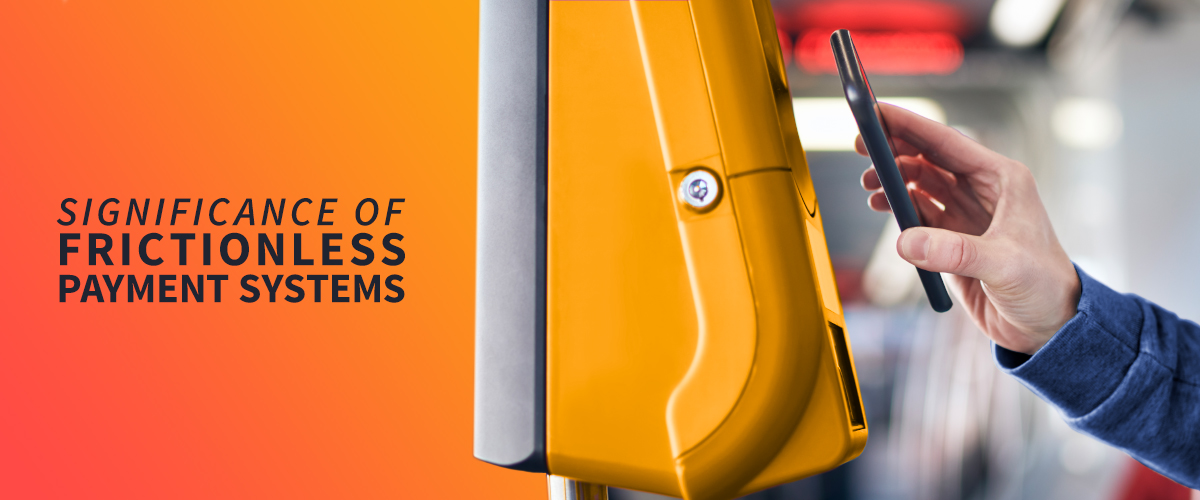
The retail industry wants to be rid of all speed bumps when it comes to paying. Frictionless payments, which are data-driven methods of payment integrate data from various devices, apps, and websites to simplify the purchasing process. This reduces the steps in both online and offline buying to minimise churn and shopping cart abandonment. Checkouts need to be quick and waiting time in the payment queue has to be minimal. For this, transaction processes has to be easy, expedited, and effortless. Key tools for frictionless shopping include mobile and digital wallets, contactless card payments, device-initiated payments, in-app and one-click payments, and auto-renewing subscriptions.
Replacing the traditional checkout experience, frictionless payments have become the default way for consumers to pay for goods and services. From mobile wallets and mobile apps to one-tap contactless card payments, customers now expect a fully frictionless payment experience as they benefit from a quick, smooth, and stress-free checkout experience. At the same time, businesses experience increased levels of customer satisfaction and lower cart abandonment rates. To stay competitive, retailers need to adopt a robust frictionless payment strategy and system. You will always be at risk of losing your customers to a competitor who proffers them a variety of frictionless payment options if you don’t do that already.
The international marketing statistics portal, Statista, estimates frictionless payment technology will grow to $8 trillion by 2024.
Types of Frictionless Payments:
Mobile wallets and digital wallets
Mobile wallets and digital wallets are often used interchangeably. Fact is, these two forms of frictionless mobile payments do differ in the way they’re applied.
Mobile wallets are mostly used by consumers who do not prefer carrying a physical wallet during in-store purchases, whereas digital wallets are mainly used for online transactions. As an example, popular digital wallets such as Google Pay and Apple Pay when used alongside mobile payment services and devices (i.e. POS terminal), they are defined as a mobile wallet due to the added in-store functionality.
Digital wallets are used through third-party smartphone apps and ensure that all your payment details are stored in one place. These apps protect consumers’ data via passwords and encryption (also known as payment tokenization), making online payments fast and secure.
Mobile payment applications
Mobile payment apps are one of the other most-used forms of frictionless mobile payments. Mobile payment applications are frequently used as a form of mobile wallet for easier in-store purchases. But there are other mobile applications, too.
Near Field Communication (NFC)
Near Field Communication (NFC) is a wholly contactless communication technology that is based on a radio frequency field that permits the exchange of data between two or more devices via touch. Tap to pay is a perfect example of this. This technology is used as a way for consumers to complete one-click and device-initiated payments in-store. It is often used in conjunction with mobile wallets.
Contactless cards
Contactless cards are a frictionless payment method that offer a safer, faster in-person checkout experience. As an off-shoot of NFC, contactless cards use short-range wireless NFC technology to make paying by card completely contactless.
Common methods of contactless card integration that you can use include:
Mobile point of sale terminals (mPOS)
- Pay By Link
- Digital and mobile wallets
- Buy online, pick up in-store (BOPIS)
- Contactless credit cards
If you have a brick-and-mortar business, you can position yourself competitively by incorporating contactless cards into your existing payments infrastructure.
Benefits of implementing a frictionless payment strategy
There are a host of reasons to move towards a frictionless payment strategy from both a buyer’s and a seller’s point of view.
Benefits to the buyer include:
- Eliminating lengthy checkout waiting times.
- Reducing the number of steps to complete checkout.
- Reducing stress at checkout (no credit card details or PINs required).
- Offering flexibility of payment options.
- Delivering enhanced security both online and on-premises. Mobile payments often require biometric authentication measures making them even more secure than chip and PIN transactions.
Benefits to the seller include:
- Lower cart abandonment rates. The easier it is to pay, the more likely customers will stay at checkout.
- Increased efficiency at checkout.
- Greater customer satisfaction rates and increased customer loyalty.
- A reduction in failed payments, easing cash flow concerns.
Secure your payment card data at the point-of-sale
Securing your customer’s payment data during checkout irrespective of the type of frictionless payment option provided or chosen is of utmost importance. Data security experts are saying that luxury and lifestyle retailers need to upgrade their cyber security measures. In India alone, the retail industry recorded 4,805 weekly instances of stolen credit card information in the last six months of 2022 compared to 1,485 such weekly attacks in the first half of the year, according to the Check Point Threat Intelligence Report. Several mid and large-size lifestyle retailers work on dated legacy systems, which are difficult to upgrade to newer technologies. The lack of skilled talent to handle complex payment security systems is also a concern. Measures like automated curation, using multi-factor authentication, and regularly updating security patches must be explored more, the report adds. Dealing with cyber conflict requires a holistic approach to protect against hacking, identity theft, and ransomware.
ETP Omni-channel POS software is flexible enough to seamlessly and easily integrate with various 3P payment applications while ensuring that all sensitive cardholder authentication data is secure. Being compliant with the security standards, we make it easier for our customers around the world to apply for PCI PA-DSS certification, where the use of compliant software solutions is a key element of demonstrating their ability to protect sensitive card data as well as elevating retail performance and customer experience with your brand.

